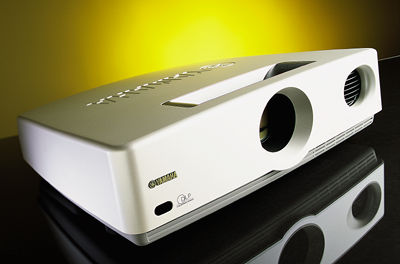Yamaha DPX-1 DLP video projector

It still does, but newer technologies now dominate a video projector business driven by the needs of business meeting rooms, not home theaters. Projectors based on one of three non-CRT technologies—LCD, LCOS (liquid crystal on silicon, of which the more familiar designation D-ILA is one variant), and DLP (Digital Light Processing)—are now common. They are, in general, small, light, less expensive than CRTs, and provide enough light output to display PowerPoint presentations and spreadsheets with the room lights up high enough to keep board members from spilling their coffee while reaching for the wrong donut.
Of these three technologies, Digital Light Processing, developed and trademarked by Texas Instruments, is currently enjoying the most explosive growth. Licensed manufacturers are using DLP technology to build unbelievably small, light projectors. But while these are still directed primarily toward business, DLP's potential for the still-growing home-theater market is not lost on manufacturers, some of whom are modifying existing commercial designs for this application. Others are designing products from the ground up with the demands of home theater in mind.
Perhaps the most surprising new DLP convert is Yamaha—surprising because the Yamaha DPX-1 comes from an audio company with no prior track record in home video. But DLP engineering relies heavily on expertise in digital design, something that's not in short supply at Yamaha.
Mirror, mirror
Unlike CRTs, DLP, LCD, and LCOS devices do not paint lines of continuous data, but instead display individual packets of information as discrete picture elements, or pixels. Every display using these technologies has a specific native resolution, which describes the actual configuration of pixels present in the display. For example, a device with a native resolution of 1024x768 has 768 horizontal rows, each one comprising 1024 pixels, for a total of 786,432 discrete elements. Such displays are often referred to as "fixed-pixel."
In a DLP display, each pixel is actually a tiny mirror reflecting the light from a projection bulb. The element, which contains the thousands of mirrors required by the system and is the central building block of a DLP projector, is called a Digital Micromirror Device (DMD). It's made using conventional semiconductor processing techniques, including sputter metal deposition, lithography, and plasma etching.
Each mirror in the DMD is independently addressed and can be rotated through an angle of ±10°. In the "on" position, the light from the mirror is routed through the projection lens. In the "off" position, the light is directed to a light-absorbent area within the projector case. The brightness is determined by how many times each pixel-mirror turns on and off at any given moment, assisted by the eye's persistence of vision. In effect, the light produced by a DLP projector is digital, and the eye/brain performs the digital-to-analog conversion.
The color of the light reflected off the mirrors is controlled by one of two methods. In the largest, most expensive DLP projectors, the light from the bulb is split into the three primary colors by a prism. Each color is controlled by its own separate DMD, then recombined before passing through the lens. This type of projector, universally referred to as a three-chip DLP, produces a light output high enough for the giant screens used for concerts and E-cinema.
But the cost of a three-chip DLP can easily run to six figures, and they're often bulkier than even the biggest CRTs. For these reasons, most DLP projectors use only a single DMD. The color is controlled by a synchronized color wheel rotating at high speed. At its most basic, this wheel has three segments, one for each of the primary colors, though there are other variations (see sidebar, "Like a Wheel").
Description
Yamaha's DPX-1 is a single-chip design. It's compact, light, and, like most fixed-pixel projectors designed for the home, is easy to get up and running. The recommended vertical setup position is either just below the bottom edge of the screen, for tabletop use, or just above the top of the screen, for ceiling-mounting (optional brackets are available for the latter). If you have to deviate from this, the projector provides both Digital Lens Shift and digital Keystone controls. (Keystoning is a trapezoidal picture distortion in which one edge of the image is wider than the opposite side—in this case the top and bottom.) The DPX-1 also has two keystone correction modes, Normal and Full. Normal is the preferred mode of operation for home theater. It maintains good geometry at the top and bottom of the picture, even with a heavy dose of keystone correction. Circles in the corners, for example, remain round.
Two inputs accept either component or RGB sources, one using five separate BNC jacks, the other a D-sub 15, VGA/XGA computer connector. Both will accept images scanned at 480i, 576i, 480p, 1035i, 1080i, and 720p and scale them to the panel's native resolution as required. Additional inputs include one composite and one S-video, a 24-pin DVI digital video input for digital RGB from a computer, and a D4 video connector (for a Japanese input format). An RS-232 connection is provided for service use. There's also a +12V trigger output for control of external components. The DVI interface is intriguing, and perhaps some of our more HTPC-involved readers could make use of it. But I had no home-theater source capable of generating such a signal, and so limited my testing to the BNC-configured component video input and, briefly, the composite.
The lens is recessed in the front of the case, with manual Focus and Zoom controls accessible from the top. Two adjustable feet are located at the bottom front. On the back are a full set of operating controls, several status lights, the main power switch, and an inlet for the detachable power cord. The remote duplicates all the controls on the projector, and it's compact, well-laid-out, and partially backlit.























































